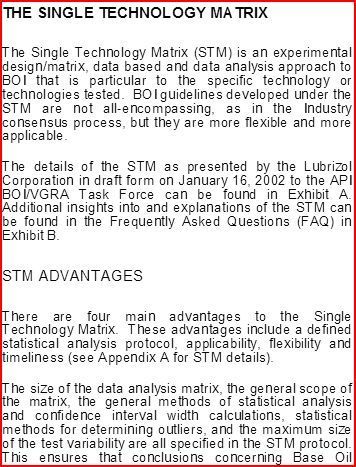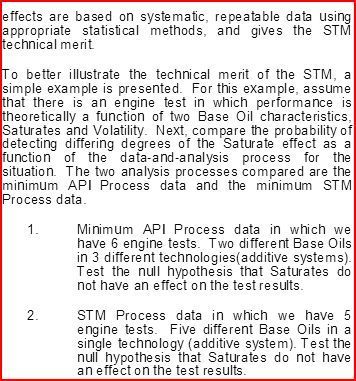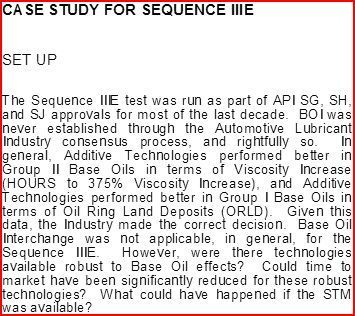Oft quoted, again, here's the skinny
from the API themselves
Quote:
APPENDIX E—API BASE OIL INTERCHANGEABILITY GUIDELINES FOR PASSENGER CAR MOTOR OILS AND DIESEL ENGINE OILS
E.1 General
E.1.1 INTRODUCTION
Not all base oils have similar physical or chemical properties or provide equivalent engine oil performance in engine testing. During engine oil manufacture, marketers and blenders have legitimate needs for flexibility in base oil usage. The API Base Oil Interchangeability Guidelines (BOI) were developed to ensure that the performance of engine oil products is not adversely affected when different base oils are used interchangeably by engine oil
blenders.
The API Base Oil Interchangeability Guidelines define the minimum prudent physical and engine testing necessary to ensure that engine oil performance is not adversely affected by substitution of one base oil for another. The Guidelines are based on actual engine test data, using different base oils, for both gasoline and diesel engine oil performance. The Passenger Car Motor Oil (PCMO) Guidelines were based on the use of API Service Category SG performance level additive technology and updated for API SH, SJ, SL, and SM quality levels. The Diesel Engine Oil Guidelines were based on the use of API Service Categories CD and CD-II performance level additive technologies and updated for CE, CF, CF-2, CG-4, CH-4, CI-4, and CJ-4 quality levels. At these relatively high levels of additive formulation, many of the base oil differences are “overwhelmed” by the additive performance package. For this reason, these guidelines should not be used to predict equivalent interchange at additive performance levels lower than API Service Categories SH and CD.
These Guidelines define the minimum acceptable level of testing for interchanging a base oil that every marketer must perform as a condition for obtaining a license.
It is understood that when comparing base stock properties, the precision of the methods listed in Table E-1 is taken into consideration.
Use of these Guidelines does not absolve the marketer of the responsibility for the actual performance of the licensed product sold in the aftermarket. The licensee must still ensure all of the engine and bench test results.
These Guidelines are subject to modifications based on new data, new or revised test methods, and/or new performance specifications. The current Guidelines must always be used.
from the API themselves
Quote:
APPENDIX E—API BASE OIL INTERCHANGEABILITY GUIDELINES FOR PASSENGER CAR MOTOR OILS AND DIESEL ENGINE OILS
E.1 General
E.1.1 INTRODUCTION
Not all base oils have similar physical or chemical properties or provide equivalent engine oil performance in engine testing. During engine oil manufacture, marketers and blenders have legitimate needs for flexibility in base oil usage. The API Base Oil Interchangeability Guidelines (BOI) were developed to ensure that the performance of engine oil products is not adversely affected when different base oils are used interchangeably by engine oil
blenders.
The API Base Oil Interchangeability Guidelines define the minimum prudent physical and engine testing necessary to ensure that engine oil performance is not adversely affected by substitution of one base oil for another. The Guidelines are based on actual engine test data, using different base oils, for both gasoline and diesel engine oil performance. The Passenger Car Motor Oil (PCMO) Guidelines were based on the use of API Service Category SG performance level additive technology and updated for API SH, SJ, SL, and SM quality levels. The Diesel Engine Oil Guidelines were based on the use of API Service Categories CD and CD-II performance level additive technologies and updated for CE, CF, CF-2, CG-4, CH-4, CI-4, and CJ-4 quality levels. At these relatively high levels of additive formulation, many of the base oil differences are “overwhelmed” by the additive performance package. For this reason, these guidelines should not be used to predict equivalent interchange at additive performance levels lower than API Service Categories SH and CD.
These Guidelines define the minimum acceptable level of testing for interchanging a base oil that every marketer must perform as a condition for obtaining a license.
It is understood that when comparing base stock properties, the precision of the methods listed in Table E-1 is taken into consideration.
Use of these Guidelines does not absolve the marketer of the responsibility for the actual performance of the licensed product sold in the aftermarket. The licensee must still ensure all of the engine and bench test results.
These Guidelines are subject to modifications based on new data, new or revised test methods, and/or new performance specifications. The current Guidelines must always be used.





